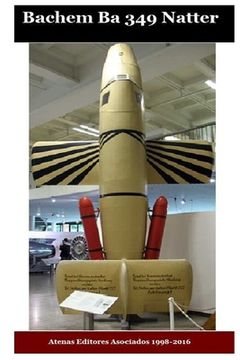Compartir
Bachem Ba 349 Natter (en Inglés)
Gustavo Uruena a.
(Autor)
·
Createspace Independent Publishing Platform
· Tapa Blanda
Bachem Ba 349 Natter (en Inglés) - Uruena a., Gustavo
16,88 €
17,76 €
Ahorras: 0,89 €
Elige la lista en la que quieres agregar tu producto o crea una nueva lista
✓ Producto agregado correctamente a la lista de deseos.
Ir a Mis Listas
Origen: Estados Unidos
(Costos de importación incluídos en el precio)
Se enviará desde nuestra bodega entre el
Miércoles 17 de Julio y el
Miércoles 31 de Julio.
Lo recibirás en cualquier lugar de España entre 1 y 5 días hábiles luego del envío.
Reseña del libro "Bachem Ba 349 Natter (en Inglés)"
The Bachem Ba 349 Natter was a World War II German point-defence rocket powered interceptor, which was to be used in a very similar way to a manned surface-to-air missile. After a vertical take-off, which eliminated the need for airfields, the majority of the flight to the Allied bombers was to be controlled by an autopilot. The primary mission of the relatively untrained pilot, was to aim the aircraft at its target bomber and fire its armament of rockets. The pilot and the fuselage containing the rocket motor would then land under separate parachutes, while the nose section was disposable. The only manned vertical take-off flight on 1 March 1945 ended in the death of the test pilot, Lothar Sieber. Von Braun Rocket Interceptor On June 15 1939 at the highlly secret Luftwaffe test station called Peenemünde-West, a diminutive aircraft took off from the aerodrome with test pilot Erich Warsutz at the controls. The Heinkel 176 was quite conventional in shape but had no propeller or air-intake. It was propelled by Hellmuth Walter's HWK R 1-203 hydrogen peroxide rocket motor.1The aircraft quickly accelerated to nearly 600 km/h, flew briefly around the aerodrome and landed. In the process it became the first aircraft to achieve a controlled flight powered only by a liquid propellant rocket motor.2 Five days later Warsitz flew a second circuit of the aerodrome. This trial was announced officially and is generally referred to in aviation histories as the first successful flight. Two years earlier Dr. Wernher von Braun and his team, in addition to their A-4 project, were also working on rocket propulsion for the Luftwaffe. The plan was for von Braun's group to develop a more
- 0% (0)
- 0% (0)
- 0% (0)
- 0% (0)
- 0% (0)
Todos los libros de nuestro catálogo son Originales.
El libro está escrito en Inglés.
La encuadernación de esta edición es Tapa Blanda.
✓ Producto agregado correctamente al carro, Ir a Pagar.

